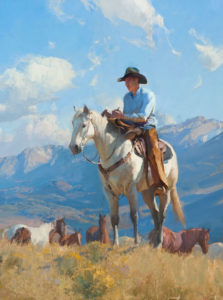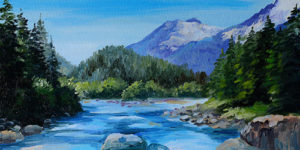Western Landscape Painting
 People have been painting for more than 30,000 years now. Did you know that the earliest oil painting is from the 14th century? But landscapes not so much; they are relatively new. It took much longer for it to evolve into the popularity it has today.
People have been painting for more than 30,000 years now. Did you know that the earliest oil painting is from the 14th century? But landscapes not so much; they are relatively new. It took much longer for it to evolve into the popularity it has today.
Landscape painting portrays scenic views of nature, with it being the primary focus of the art. Artists have been painting landscapes since ancient times as far back as western-style paintings.
This article walks you through Western-style paintings, landscapes, history, the masters of the art, famous paintings and painters, and much more.
What Are Western-style Paintings?
Western-style paintings are used to depict the art form that originated in Western Europe. Currently, the art form is widespread and generally used to denote paintings that have their roots in Europe.
Until the 19th century, it has a more classical mode of production, after which more modern, abstract, and conceptual forms like abstract and modern gained favor. Initially, it served aristocracy and religious patronage, but it found more audiences in the middle class.
Western art peaked in the Renaissance period along with the refinement, use of perspective, stained glass, tapestry, etc.
The different types of western-style paintings:
- Modernism
- Impressionism
- Photorealism
- Surrealism
- Abstraction
- Expressionism
On the other hand, Western-American art was treated more like an impoverished and unwanted art before the 20th century. It was in this period that it gained respect as a period for studying. Rather than modern art, Western-American art focussed more on the subject than style.
Basic Theme of Western-style Paintings
Originating in the 1840s, the American-Western art movement wasn’t bound to approach and style instead of subjects. It was very distinct from European art and had no elements of Europe.
Compared to the western-style paintings, the Western American paintings were mostly around cowboys and American Indians, their day-to-day activities and life as it was then. It also showcases the social, economic, and political factors of American society.
In the 18th century, the paintings mainly consisted of heroic landscapes, and accuracy wasn’t much thought. Later by the 19th century, the theme centered around cowboys and native Americans, with the latter heralded as Noble Red Men. But the scenery changed at the end of the century as the Indians were defeated and controlled by the White settlers.
As the 20th century rolled by, there was a massive development in the Industrial sector; buffalo and cowboys vanished, leading to a more realistic style of the west.
Masters of Western Art
Western art has two great masters whom all the other artists look to:
They laid the foundation for Western-American Art. Surprisingly both the artists hailed from the east and left for the west in the early 1880s.
Russel captured the colorful life of the west, buffalo in the wild, Indians, cowboys, and the spirit of the west in his paintings. On the other hand, Remington portrayed the lives of the soldiers and the cowboys in a more dramatic manner.
Russel’s home in Montana has been converted to a museum, holding one of the largest collections of the artist.
Their important works include:
- Cavalry in an Arizona Sandstorm
- A Dash for the Timber
- The Fall of the Cowboy
- Water Girl
Another similar artist in the period predating the masters is Albert Bierstadt. He is known for his works of the American West. His California Coast and Among the Sierra Nevada Mountains, California are among the many notable works.
What Are Landscape Paintings?
Landscape painting illustrates open spaces and natural scenery like mountains, canyons, forests, valleys, lakes and rivers, etc. Few paintings may include people and man-made structures, while others may not. Moreover, they offer a wide view of the scenery and generally have some focus on the sky.
Apart from landforms, seascapes, cloudscapes, cloudscapes, etc., also come under this genre in modern paintings.
History of Landscape Painting
The history of landscape paintings spans nearly 3,500 years.
Landscape as a genre did not emerge as a western art until the Renaissance period. It started as a background for the subjects in focus. You can see such kind in the works of artists like Giovanni Bellini (The Agony in the Garden and Saint Jerome Reading in a Landscape) and later by Giorgione (The Tempest, Adoration of the Shepherds). Later, artists began celebrating nature in their paintings. Pieter Bruegel the Elder, the Flemish artist, began painting highly detailed and colorful landscapes. (Hunters in the Snow, The Harvesters)
In a similar way, 17th-century dutch artists like Jacob van Ruisdael, Meindert Hobbema, and Aelbert Cuyp led the era with notable works of art featuring ominous cloudy sky, setting the tone for the scene. On the other hand, French painters like Antoine Watteau and Jean-Honoré Fragonard developed romantic outdoor landscaped with precise detail and delicate coloring.
By the 19th century, artists embraced the romantic movement, and landscapes were finally accepted as a respectable genre in Europe and the US as well. John Constable and J.M.W. Turner from England, Caspar David Friedrich from Germany, Jean-François Millet, Théodore Rousseau, and Charles-François Daubigny from France were united in the way they captured nature and its elements in their paintings.
With the further invention of tools, painters took their canvas outdoors, leading the way for impressionism.
Famous Claude Monet and Pierre-Auguste Renoir influenced artists like Vincent van Gogh and Vincent van Gogh. Finally, the 20th century saw the birth of Modernism, Abstract landscapes, cubism, and surrealism.
Landscape Painting in Western Art
Even though artists learned how to depict far and near objects in their paintings, the academic circles didn’t much accept it in western art. Landscapes were mostly pushed back, with spiritual and political figures being in prominence.
However, the genre was widely accepted by 17th-century Dutch painters. By the 18th and 19th centuries, religious paintings declined, paving the way for romanticism which promoted nature in all its beauty.
In the American west, it was the Hudson River Valley School. First-members from the school like Asher B. Durand, Thomas Doughty, and Thomas Cole led the era with younger artists like Frederic Edwin Church, Jasper Cropsey, Fitz Henry Lane, and Albert Bierstadt.
They painted the rugged nature of the western landscape from the Hudson River Valley to Eastern locales to the vast American West.
Which Great American Artist Painted Pictures of the Old American West?
Frederic Remington, the American painter, illustrator, and sculptor, specialized in pictures of the Old West. His works depicted the cowboys, US cavalry, and the harsh desert lands. His style was more naturalistic and even impressionist to an extent. The focal point of his paintings was mostly people and animals set against the western landscape. He was also one of the first artists to depict the horses in motion, which other western artists later copied.
What Is the Oldest Recorded Landscape Painting and Where Is it From?
The earliest recorded western art is the Fresco in Akrotiri, an Aegean Bronze Age settlement on Santorini. It was from 1627, well preserved under the volcanic ash until archeologists unearthed it 50 years ago.
Famous Landscape Paintings
 Landscapes did not always have the recognition it has now. With the Barbizon School’s birth, the nature of the paintings turned to be more open-air with nature, green forests, rocky cliffs, fields, etc.
Landscapes did not always have the recognition it has now. With the Barbizon School’s birth, the nature of the paintings turned to be more open-air with nature, green forests, rocky cliffs, fields, etc.
Here are some of the famous paintings:
- Spring or Earthly Paradise by Nicolas Poussin: The artist is famously known as the inventor of ideal landscapes. The oil painting depicts Adam and Eve in the vicinity of the infamous apple tree. It is famous for its warm colors and pleasant light.
- The Grand Canal at the Church of La Salute by Giovanni Antonio Canal: The oil canvas sets the scene in Venice with the grand canal in the background with gondoliers as well as the merchants. The Italian master is very particular about realistic representation.
- Hill with Lighthouse by Edward Hopper: Oil paintings by the artist have a mysterious side to them, such as this one with its lonely house and a lighthouse set on a hill. The absence of the sea adds to the deserted scene.
- Trouville Beach by Eugène Boudin: The artist takes most of his inspiration from the sky, just like with this one. In Trouville Beach, he captures the intensity of the Normandy coasts with a poetic touch.
- Starry Night by Vincent Van Gogh: The most famous work of the artist, it depicts contrasting colors, spirals, sharp features showcasing the demons he was fighting then.
- Vaquero by Frederic Remington: The artist, with his hero-worship of the cowboys, created works of legend and drama. His documentary-style images were an illustration of what lay in the lawless lands. Vaquero is a figurative reproduction of the everyday life of cowboys set on the rugged open desert and the blistering summer day.
Famous Landscape Artists
Below are some famous artists from the American West and Europe:
- Leonardo da Vinci – Though not famous for this genre, his Paesaggio con Fiume was ahead of his time and paved the way for other artists.
- John Constable – An English artist who followed romanticism and is famous for his depiction of Dedham Vale
- Claude Monet – As the founder of the French Impressionist movement, he changed the way painters depicted nature in art.
- Paul Cézanne – A French post-impressionist painter painted landscapes with a rich imagination and a light and airy painting style.
- Vincent van Gogh – The most famous dutch post-impressionist painter practicing western art; He painted everything from landscapes to portraits and still life.
- Charles Marion Russell – The most prolific among the western artists who dabbled in oil canvas, watercolors, and bronze sculptures. His style included landscapes, cowboys, and Native Americans inspired by his visits to California, Colorado, and Arizona.
- Albert Bierstadt – AGerman-American painter known for his landscapes, particularly the Yosemite; He used charcoal, watercolor, oil, pastel, and ink in his work.
- Thomas Moran -An English-born painter who used intense shades of color to capture the grandeur of nature, especially the Grand Canyon and Yosemite; He was adept in watercolor, oil printmaking, engraving, and lithography.
Conclusion
Landscape paintings have gone through so many changes that it is difficult to predict how they will develop in the coming years. But, whatever the form it takes, it makes for beautiful home decor.
Paintings of the American West depict everything from desert and canyons to nature in all its beautiful colors. They are also a visual representation of how life was in the old west. Reproductions of the oil canvas paintings from the masters are available for sale in most online shops and galleries.
 Fine Art Publishing has a vast collection of western-style paintings and landscape art from nationally-acclaimed and world-famous artists. Contact us if you’d like to see or purchase any of these limited-edition prints or paintings.
Fine Art Publishing has a vast collection of western-style paintings and landscape art from nationally-acclaimed and world-famous artists. Contact us if you’d like to see or purchase any of these limited-edition prints or paintings.